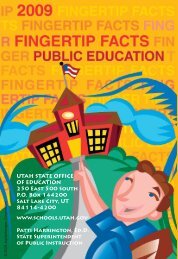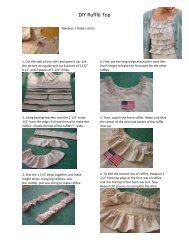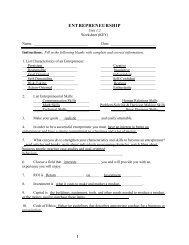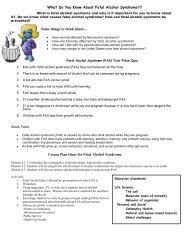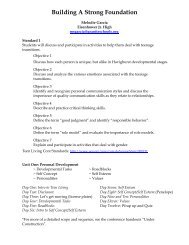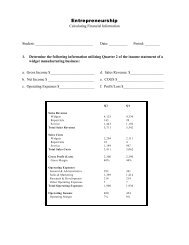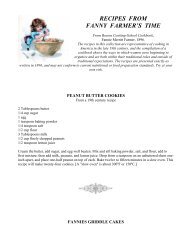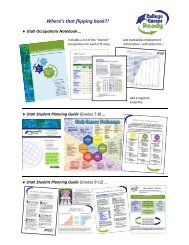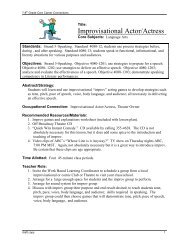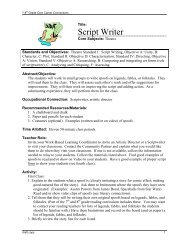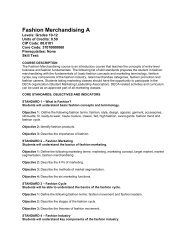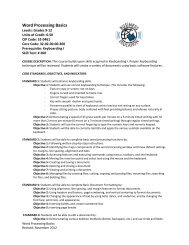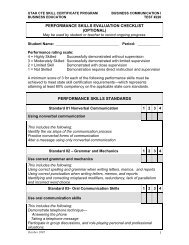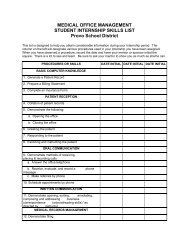Fashion Strategies
Fashion Strategies
Fashion Strategies
Create successful ePaper yourself
Turn your PDF publications into a flip-book with our unique Google optimized e-Paper software.
<strong>Fashion</strong> <strong>Strategies</strong> 9/2013<br />
Levels: Grades 9-12<br />
Units of Credit: 0.50<br />
CIP Code: 20.0306<br />
Core Code: 34-01-00-00-140<br />
Prerequisite: None<br />
Skill Test: # 355<br />
COURSE DESCRIPTION<br />
This course explores how fashion influences everyday life and introduces students to the fashion industry.<br />
Topics covered include: fashion fundamentals, elements and principles of design, textiles, consumerism,<br />
and fashion related careers, with an emphasis on personal application. FCCLA may be an integral part of<br />
this course. (Standards 1-5 will be covered on Skill Certification Test #355)<br />
CORE STANDARDS, OBJECTIVES, AND INDICATORS<br />
Performance Objective 1: Complete FCCLA Step One. http://www.uen.org/cte/facs_cabinet/facs_cabinet10.shtml<br />
STANDARD 1<br />
Students will explore the fundamentals of fashion.<br />
Objective 1: Identify why we wear clothes. (protection, adornment, identification, modesty, status)<br />
Objective 2: Define terminology.<br />
a. Common terms: accessories, avant-garde, classic, design details, draped, fad/craze, fashion,<br />
fashion cycle (introduction, rise, peak, decline, outdated), garment type, haute couture, ready to<br />
wear, style, tailored, trend, wardrobe.<br />
b. Basic design details: shirts, collars, sleeves, necklines, dresses, skirts, pants/trousers, jackets,<br />
etc.<br />
Objective 3: Discuss the history of fashion, the cultural influences and their impact on drastic fashion<br />
changes in each decade.<br />
a. Trends repeat every 20-30 years<br />
b. 1890’s – Victorian Era. Gibson Girl, corset, bustle, hourglass silhouette.<br />
c. 1900’s – Industrial Revolution Era. Duster coat, shirtwaist, Leg O’ Mutton sleeves, s-curve<br />
silhouette.<br />
d. 1910’s – WWI Era. Hobble skirt, bathing suit, bloomers, inverted triangle silhouette.<br />
e. 1920’s – “Roaring ‘20’s’ Era. Flapper, costume jewelry, cloche’ hat, tubular silhouette.<br />
f. 1930’s – Depression Era, bias cut dresses, waistline restored, hemlines dropped, hand-me<br />
downs, flour sack clothing, hourglass silhouette.<br />
g. 1940s – WWII Era. Convertible suit, slacks, Eisenhower jacket, inverted triangle silhouette.<br />
h. 1950s – Rock n’ Roll era. Poodle skirts, saddle shoes, Capri pants, the new look (Christian Dior),<br />
teenagers, hourglass silhouette.<br />
i. 1960s – Civil rights Era. Miniskirts, pantsuits, pillbox hat, tubular silhouette.<br />
j. 1970s – Hippy to Disco Era. Unisex, bold flower prints, platform shoes, triangular silhouette.<br />
k. 1980s – Yuppie Era. Logo wear, designer jeans, exercise wear, inverted triangle silhouette.<br />
l. 1990s – The Dot Com Era. Bare midriff, rejection of fashion, grunge.<br />
m. 2000s – Inspiration drawn from the previous decades – anything goes!<br />
Objective 4: Identify and discuss characteristics of fashion capitals and designers.<br />
a. Major <strong>Fashion</strong> Capitals: Paris, France (First <strong>Fashion</strong> capital); Milan, Italy,(Elegance and<br />
luxurious fabrics); Tokyo, Japan (Asian influence, loose and unstructured); London, England<br />
<strong>Fashion</strong> <strong>Strategies</strong> Page 1 of 3<br />
Revised: September 2013
(Modern British designers tend to favor a "rebel" street look); New York City, New York (Clean cut<br />
casual style). (See FS addendum for added information)<br />
b. Discuss designers of influence (Coco Chanel, Christian Dior).<br />
Objective 5: Identify fashion related careers. (costume designer, museum curator, etc.)<br />
Performance Objective 2: Prepare an oral or written report on a fashion capital, fashion designer,<br />
historic era, or fashion career that has influenced fashion.<br />
STANDARD 2<br />
Students will recognize and use the principles and elements of fashion design.<br />
Objective 1: Demonstrate knowledge of the elements (tools) of design.<br />
a. Line (vertical, horizontal, curved, and diagonal - visual effects)<br />
b. Shape/clothing silhouette<br />
c. Color<br />
I. Color basics: hue, primary, secondary, tertiary/intermediate, location on a 12 color wheel<br />
II. Value: tints, shades<br />
III.<br />
IV.<br />
Intensity: brightness, dullness (tones)<br />
Schemes: neutral, accented neutral, monochromatic, triadic, analogous/adjacent,<br />
complementary<br />
d. Texture (tactile, visual)<br />
e. Pattern (naturalistic, conventional/stylized, geometric, abstract)<br />
Objective 2: Demonstrate knowledge of the principles (rules) of design.<br />
a. Proportion/Scale<br />
b. Balance: formal/symmetrical, informal/asymmetrical<br />
c. Emphasis: focal point<br />
d. Rhythm: gradation, opposition, radiation, repetition, transition<br />
e. Harmony: unity and variety<br />
Objective 3: Identify related careers (fashion designer, illustrator, etc.).<br />
Performance Objective 3: Create a color wheel identifying primary, secondary, and tertiary/intermediate<br />
colors, the warm and cool colors, and tints and shades.<br />
Performance Objective 4: Create a fashion project or professional presentation incorporating the<br />
principles and elements of design; explain in writing, (design, portfolio, power point, display, etc.).<br />
STANDARD 3<br />
Students will understand the use of textiles in fashion.<br />
Objective 1: Identify basic fibers, the characteristics, use and care of the following textiles.<br />
a. Identify sources and characteristics of natural fibers: cotton, linen, silk, wool.<br />
b. Identify sources and characteristics of synthetic fibers: nylon, polyester, acrylic, rayon, spandex,<br />
acetate.<br />
Objective 2: Recognize various types of fabric construction.<br />
a. Identify basic weaves (plain, twill, satin).<br />
b. Define knits<br />
c. Identify non-woven fabrics. (felt )<br />
d. Fabric Finishes (solution, yarn, and piece dying, printing)<br />
Objective 3: Identify textile related careers (textile designer, textile chemist, fabric designer, etc.).<br />
<strong>Fashion</strong> <strong>Strategies</strong> Page 2 of 3<br />
Revised: September 2013
Performance Objective 5: Create a fabric reference guide consisting of natural/synthetic fibers and<br />
woven/knit fabrics.<br />
STANDARD 4<br />
Students will identify consumer strategies associated with fashion.<br />
Objective 1: Identify consumer influences.<br />
a. Cultural and economic conditions<br />
b. Media & advertising<br />
c. Technology<br />
d. Purchasing influences (conformity, peer pressure, social expectations, culture [ethnicity, religion],<br />
individuality)<br />
Objective 2: Identify various types of purchasing options:<br />
a. Types of stores (chain, department, specialty, discount, manufacturer-owned, outlet)<br />
b. Internet & Catalog<br />
Objective 3: Identify consumer skills and purchasing decisions.<br />
a. Judging quality (basic construction, seams, matching plaid, attachment of fasteners)<br />
b. Cost per wear<br />
c. Smart shopping (sales, comparison shop, coupons, membership clubs)<br />
d. Labels (required by law: fiber content, garment care, international care symbols, manufacturer<br />
number, country of origin)<br />
e. Hang tags (optional: brand name, advertising, logo, etc.)<br />
Objective 4: Identify related careers (buyer, retail sales, journalist, advertising, etc.).<br />
STANDARD 5<br />
Students will evaluate personal fashion characteristics.<br />
Objective 1: Aspects of personal appearance.<br />
a. Personal styles - yin/yang<br />
b. Body types/silhouette: Hourglass, Triangle, Inverted Triangle, Rectangle<br />
c. Personal coloring (warm and cool)<br />
Objective 2: Identify and analyze wardrobe needs for a personal lifestyle<br />
a. Basic 8 pieces - Classic, well-constructed, cost per wear, neutral + a favorite color<br />
(Long sleeve T-shirt, Short sleeve T-shirt, Tank top, Button down shirt (tailored), Light weight<br />
cardigan, Little black dress, Jeans, Dress pants)<br />
b. Trendy – current style and patterns, colorful, fun, fad to mix & match<br />
(Woven shirt, Skirt, Patterned jeans, Dressy jacket, Casual jacket, Patterned scarf)<br />
Objective 3: Identify related careers (fashion stylist, personal shopper, etc.).<br />
Performance Objective 6: Plan a personal wardrobe using the eight basic pieces and six trendy pieces.<br />
Accessorize based on personal taste. Create a visual representation and write a description that explains<br />
how this collection expresses your personal fashion characteristics.<br />
<strong>Fashion</strong> <strong>Strategies</strong> Page 3 of 3<br />
Revised: September 2013



